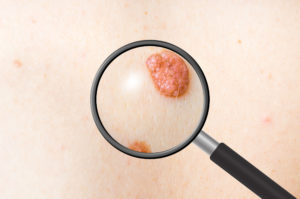What to Expect From a Skin Biopsy
 A skin biopsy is the removal of layers of skin for laboratory analysis. This can be done right in your preferred doctor’s office and requires no recovery downtime.
A skin biopsy is the removal of layers of skin for laboratory analysis. This can be done right in your preferred doctor’s office and requires no recovery downtime.
Before the Procedure:
Your doctor will assess the area of the skin in question and ask you questions about how the condition developed. They will also review your health history and current medications. You may be asked to stop taking certain medications 24 hours before the skin biopsy procedure.
At the doctor’s office, you will be asked to undress and change into a clean gown which will give the doctor easier access to the biopsy site. The biopsy site will then be thoroughly cleaned before a local anesthetic is injected. You will feel a burning sensation for a few seconds before the treatment area becomes completely numb.
During the Procedure:
The procedure itself depends on the type of biopsy you are having done. Your doctor will choose the biopsy method to best remove the problematic area. The three types of skin biopsies are:
- Shave biopsy
During a shave biopsy, a scalpel or other razor-like tool is used to shave the epidermis and part of the dermis off. Because of this, you will experience some bleeding during the procedure. Pressure and a topical anesthetic are typically applied during a shave biopsy.
- Puncture biopsy
With a puncture biopsy, a small tool with a sharp circular end is inserted into the skin, removing the epidermis, dermis, and some subdermal fat. A few stitches may be required afterward, plus a tight bandage to prevent bleeding.
- Excision biopsy
During an excision biopsy, a scalpel is used to remove a larger area of skin down to, or even, through the subdermal fat. Stitches are usually required along with a tight bandage to control bleeding after this type of biopsy.
After the Procedure:
After-care for a skin biopsy is just basic wound care. Keeping the treatment area clean and the bandage changed when dirty is the most important part of care at home.
Avoid any movement that puts pressure on or stretches the treatment area until it is fully healed. Also, avoid submerging the biopsy site in water for at least a week after the procedure.
Continue wound care until the stitches are removed (if you got any) and the treatment site has healed. Your skin should be completely healed within two months, with some people reporting full healing in just a few weeks.
Dr. Kavita Rao and her stellar team in St. Petersburg have done countless successful skin biopsy procedures. They have the experience and tools needed to provide comprehensive medical care to the residents of Tampa Bay. If you’re experiencing any skin issues, call (727) 525-0900 or contact us online to schedule an appointment today!

